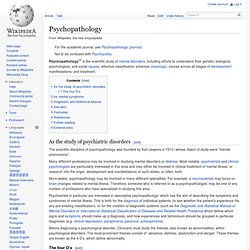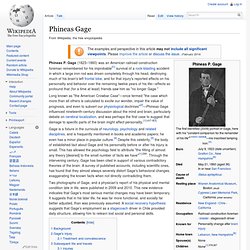

Psychopathology. Psychopathology[a] is the scientific study of mental disorders, including efforts to understand their genetic, biological, psychological, and social causes; effective classification schemes (nosology); course across all stages of development; manifestations; and treatment.

As the study of psychiatric disorders[edit] The scientific discipline of psychopathology was founded by Karl Jaspers in 1913, whose object of study were "mental phenomena". Many different professions may be involved in studying mental disorders or distress. Most notably, psychiatrists and clinical psychologists are particularly interested in this area and may either be involved in clinical treatment of mental illness, or research into the origin, development and manifestations of such states, or often, both. More widely, psychopathology may be involved in many different specialties. Phineas Gage. Phineas P.

Gage (1823–1860) was an American railroad construction foreman remembered for his improbable[C] survival of a rock-blasting accident in which a large iron rod was driven completely through his head, destroying much of his brain's left frontal lobe, and for that injury's reported effects on his personality and behavior over the remaining twelve years of his life—effects so profound that (for a time at least) friends saw him as "no longer Gage. " Long known as "the American Crowbar Case"—once termed "the case which more than all others is calculated to excite our wonder, impair the value of prognosis, and even to subvert our physiological doctrines"[2]—Phineas Gage influenced nineteenth-century discussion about the mind and brain, particularly debate on cerebral localization, and was perhaps the first case to suggest that damage to specific parts of the brain might affect personality.[1]:ch7-9[3] Background[edit] Gage's injury[edit] Harlow took charge of the case around 6 p.m.
Electroencephalography. Simultaneous video and EEG recording of two guitarists improvising.

Electroencephalography (EEG) is the recording of electrical activity along the scalp. EEG measures voltage fluctuations resulting from ionic current flows within the neurons of the brain.[1] In clinical contexts, EEG refers to the recording of the brain's spontaneous electrical activity over a short period of time, usually 20–40 minutes, as recorded from multiple electrodes placed on the scalp. Diagnostic applications generally focus on the spectral content of EEG, that is, the type of neural oscillations that can be observed in EEG signals. EEG is most often used to diagnose epilepsy, which causes obvious abnormalities in EEG readings.[2] It is also used to diagnose sleep disorders, coma, encephalopathies, and brain death.